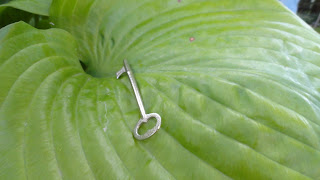Adaptation of a Plant:
The ability of a plant to adjust to the climate it lives in.
Demonstrated by the hen and chick plant above, which has adapted to dry sunny conditions along side our driveway.
Analogous structures:
The structures of different species having similar functions
but not from the same evolutionary origins.
The seagulls above have bone structure in their wings similar to the arms of a human.
Anther and filament of stamen:
The stamen is the pollen-producing reproductive structure of a plant.
The anther is the pollen covered bulb at the end of the filament.
Autotroph:
Any organism capable of creating its own food.
Exhibited by the hosta above, which uses photosynthesis to create nourishment.
Auxin producing area of a plant:
The new shoot tips of this cucumber plant are where new shoots or buds grow.
Bilateral symmetry:
As shown by this voodoo lily, a central axis which divides the plant on one plane into symmetrical right and left halves.
Endosperm:
Seed tissue. The popcorn above is a seed.
Hermaphrodite:
An organism that has both male and female reproductive organs.
Worm.
An organism that has both male and female reproductive organs.
Worm.
Homeostasis:
The ability to maintain internal stability. A human possess this ability.
Hi mom!
Adaptation of an animal:
The ability of an animal to get used to the climate in which it lives.
This critter (with too many legs) is adapted to living under rocks, in darkness.
The ability of an animal to get used to the climate in which it lives.
This critter (with too many legs) is adapted to living under rocks, in darkness.
ATP:
Cells use this as a coenzyme. ATP is found in every single cell in the body.
Long-day Plant: is a plant that requires a short night and long day (more than 12 hours) to bloom. Examples are lettuce (above), potatoes, spinach and cone flowers.
Detrivore:
An organism that eats decomposing organic matter.
Zombie! Oh wait, those eat living matter.
Hydrophobic:
Not compatible with water. Oil and water never mix.














No comments:
Post a Comment
Note: Only a member of this blog may post a comment.